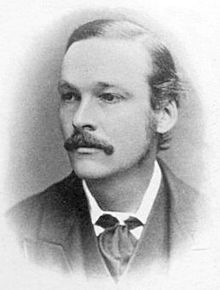Francis Maitland Balfour facts for kids
Quick facts for kids
Francis Maitland Balfour
|
|
|---|---|
 |
|
| Born | 10 November 1851 Edinburgh, Scotland
|
| Died | 19 July 1882 (aged 30) Chamonix, France
|
| Awards | Royal Medal (1881) |
| Scientific career | |
| Fields | embryology |
| Institutions | Trinity College, Cambridge |
Francis (Frank) Maitland Balfour (born November 10, 1851 – died July 19, 1882) was a very important British biologist. He was known for his studies on how animals develop, a field called embryology. Many scientists thought he was one of the best biologists of his time. They even saw him as a possible successor to Charles Darwin. Sadly, he died young while climbing Mont Blanc in the Alps.
Contents
Early Life and Education
Francis Balfour was born in Edinburgh, Scotland. He was the younger brother of Arthur Balfour, who later became a famous politician.
He went to Harrow School. There, he shared the Natural History Prize with Arthur Evans. Arthur Evans later became a well-known archaeologist. A teacher named George Griffith helped Francis develop his interest in natural science. He had already learned to love geology from his mother.
In 1870, Francis went to Trinity College, Cambridge. He quickly became a natural science scholar. In 1873, he earned a high rank in the Natural Science Tripos exam.
Developing a Scientific Career
In 1871, Sir Michael Foster gave some lectures on embryology. These lectures made Balfour very interested in how animals form and grow. After his exams, he was chosen to study at the Naples zoological station. This was a special place for studying sea animals.
Important Research and Publications
Balfour's most important work was a large book called Comparative Embryology. It came out in two volumes. The first volume, published in 1880, was about Invertebrates. These are animals without a backbone, like insects or worms. The second volume, from 1881, covered Vertebrates. These are animals with a backbone, like fish, birds, and mammals.
This book showed his strong scientific imagination. It also showed his careful way of telling facts from ideas. The book quickly became very popular. It was seen as a great summary of many observations about animal development. It was also a work of original research.
Recognition and New Position
Balfour's reputation grew quickly. Other universities wanted him to come and teach for them. He was asked to join Oxford University and Edinburgh University. Even though he was only a college lecturer, he chose to stay at Cambridge.
In 1882, Cambridge University created a special job just for him. It was called the Chair of Animal Morphology. This was a very important position.
Views on Evolution
Francis Balfour believed strongly in Darwinism, the ideas of Charles Darwin. However, he did not agree with Darwin on everything. For example, they had different ideas about how larvae develop. Larvae are the young forms of some animals, like caterpillars or tadpoles.
Darwin thought larvae came from the same ancestors as adult animals. But Balfour believed that most larvae were "secondary." This meant they were added to an animal's development later in evolution. He thought these larvae appeared after the adult forms were already established.
For example, he studied sea urchins and starfish, called echinoderms. He argued that their larvae, which look different from the adults, must have appeared later. He disagreed with another scientist, Haeckel, who thought these larvae proved that echinoderms came from ancestors with a different body shape.
Awards and Honors
In June 1878, Francis Balfour became a Fellow of the Royal Society. This is a very high honor for scientists in Britain. In 1881, he received the Royal Medal. He earned this award for his many important studies on animal forms. He was especially recognized for his work on how certain organs and nerves develop in animals with backbones. He also studied the development of sharks and rays.
Tragic Early Death
Sadly, Francis Balfour never got to give a lecture in his new important job. Soon after he was appointed, he became sick with typhoid fever. He went to the Alps to get better.
On July 19, 1882, Balfour and his guide, Johann Petrus, were climbing in the Alps. They were attempting to climb the Aiguille Blanche, a part of Mont Blanc. This mountain was very difficult to climb and had not been fully explored. Both Balfour and his guide died during this climb.
Many scientists were very sad about his death. Charles Darwin called him the "Scottish Cuvier," comparing him to a famous French naturalist. Thomas Henry Huxley, another important scientist, said Balfour's death was a great loss to science. Francis Balfour was buried in Whittingehame, Scotland.
Selected Publications
- The Elements of Embryology (1874) [with Michael Foster]
- A Treatise on Comparative Embryology (Volume 1, Volume 2, 1880-1881)
See also
 In Spanish: Francis Maitland Balfour para niños
In Spanish: Francis Maitland Balfour para niños

